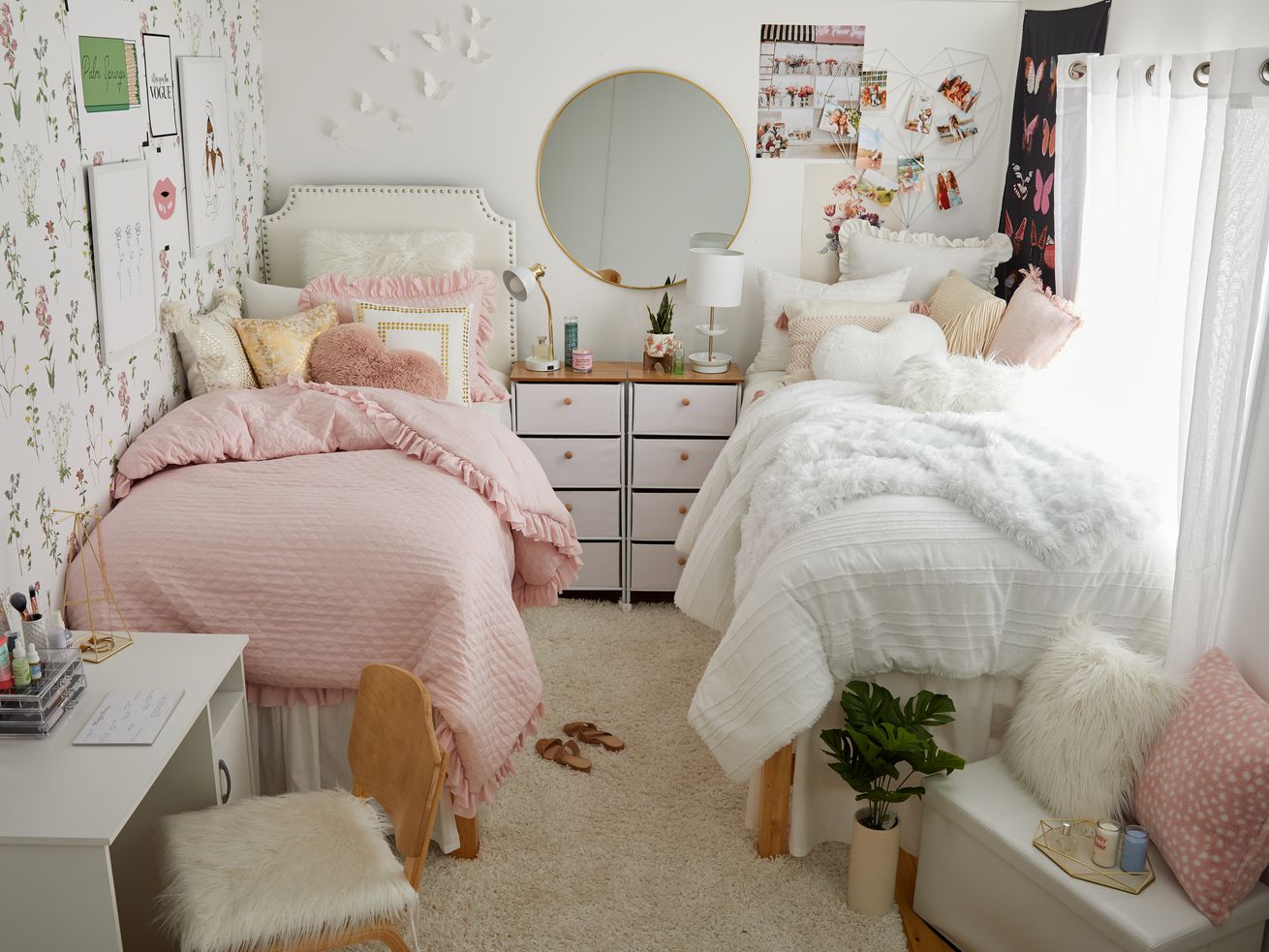For college students, dorm decor can showcase newly discovered identities. For parents, it can be a second nesting phase. It all adds up to a lot of shopping.
The “it” bag among a subset of shoppers-in-the-know is adorned with tacky logos, contains a garish combination of two primary colors, and has a kind of glitchy zipper. Despite all this, it is sometimes unavailable due to high demand. You can often find it marked up by 300 percent on third-party marketplace sites.
Gucci? Coach? Nope, it’s the Frakta bag, courtesy of Swedish designer … Ikea. I just bought six of them direct from the retailer, at $4.99 each.
The Frakta bags are made out of the same blue plasticky material as Ikea’s large open shopping bags, except they’re shaped like duffel bags and have a zipper and extra straps that can function as a backpack. I know about them from a Facebook page called Dorm Chatter, a 35,000-follower-strong bastion of mostly moms who debate the best fans, sheets, and, yes, storage bags, for moving their students to college.
In the early ’90s, I attended a state university with standard cinderblock dorm rooms. I decorated it with posters, milk crates, and a brown, beat-up, rented mini-fridge. So I was not fully prepared for what these amateur dorm experts were telling me my kid, who will be a freshman this fall attending college six hours away, “needed” for his room.
First and foremost, the Frakta bags. Group members posted tons of pictures showing how much stuff could fit in one and their superior stackability in the back of SUVs. Plus, they can have a second life as travel bags or as laundry bags. I was convinced.
But then it started to get more esoteric. There’s the Woozoo, a globular, oscillating fan that also moves up and down for superior cooling, which regularly sells out at Costco. There’s the Lucid mattress topper (oh, shit, he needs a mattress topper?), for which it had been determined that the 3-inch thickness was ideal. There are multiple pool noodle hacks — a shockingly popular DIY tool — including one in which you slice the noodle in half lengthwise and put it on the bottom edge of a lofted bed so taller kids don’t hit their heads on the frame.
There were questions about temporary wallpaper and bedskirts and even the feasibility of portable in-room washing machines. I quickly panicked, overwhelmed by the sheer amount of stuff. I had to shut my laptop and calm myself down before I mindlessly spent hundreds of dollars on over-the-fridge storage shelves and dozens of Command hooks.
The dorm shopping economy is a robust one, with plenty of places to buy things that you see on Instagram or TikTok or Facebook groups. In addition to Amazon, the traditional dorm retailers like Target and Bed Bath & Beyond offer dorm registries, complete with discounts. Then there are specialty retailers like OCM, DormCo, and Dormify that offer dorm-specific storage options and decor. They even sell full packages that allow students and families to buy everything all at once, like OCM’s 27-piece, $250 package that includes everything from sheets and towels to a laundry bag and surge protector.
Dormify, which has the trendiest products of the bunch and even offers design services, just landed a Series B round of private equity funding this spring and counts American Eagle Outfitters as a strategic investor. Social media has changed the game on dorm shopping, but also, students look to express their personalities via decor and parents see one last opportunity to take care of their children at the end of their childhoods.
Aaryn Peterson, a parent in Portland, Oregon, estimates she spent close to $3,000 buying stuff for her freshman daughter Grace last year. She posted a picture on the Dorm Chatter page of her in a UHaul on the last day of school surrounded by boxes, with an impassioned plea that read, in part: “Don’t be me. Learn from my mistakes.” She got almost 500 responses in return, including some sweary and defensive DMs. She says she was just trying to provide some hindsight wisdom for all of us newbies.
“[Grace] didn’t want 7,000 throw pillows. She didn’t want them, but I kept buying cute ones,” says Peterson. “And it was because I just kept thinking, ‘She needs this to be comfortable. She needs this to feel all the things.’”
I empathize with the pull of that inclination as I debate whether or not my kid needs a special bed caddy for his electronics.
According to a July report from the consulting firm Deloitte, which publishes annual college shopping surveys, $26.7 billion will be spent on back-to-college items, an average of about $1,459 per student. Computers and gadgets make up a big chunk of this, but dorm appliances/furniture will account for $6.8 billion of the total.
“It’s really expensive to outfit a complete dorm. It can be thousands without really even going over the top,” says Fran Bardio, the founder of the Dorm Chatter page. The group’s first iteration was for discussing college admissions, a process she found stressful and confusing. Other parents did, too, but the conversation soon transitioned to dorms, so she started Dorm Chatter separately three years ago when her first child was heading off to school. (She says she gets about 60 comments a day on the page and currently there is a queue of 1,000 people requesting page access.)
Typical dorm rooms are small and sparsely furnished with a desk, a closet, a small chest of drawers, and a bed that can usually be lofted to different heights. The shopping checklist my son’s school sent out was a few dozen bullet points of mostly obvious items: towels, hangers, chargers. A comprehensive document floating around on Dorm Chatter is four pages long and includes helpful items I didn’t even think about like water bottles, and things I’m not sure are really necessary, like husband pillows. Once you start getting into decor like fairy lights and ornamental headboards (more on this extremely hot item shortly), you can see how the bill can climb.
This is, of course, on top of ever-increasing college costs that leave many students with debilitating debt. Tuition for the 2020-2021 school year averaged $41,411 at private colleges, and $11,171 for in-state students and $26,809 for out-of-state students at state schools, according to US News data. Room and board can add thousands more to the total.
The McMansioning that is sometimes happening in dorms can have the unfortunate effect of mirroring the financial inequality in society. “You can definitely tell where the equity gaps are based on what someone’s room looks like. We see some people investing quite a bit of money on their residential spaces and then some who can’t afford to do that at all,” says Melantha Ardrey, the director of student life at the College of Charleston.
In a Reddit post a few years ago, a user said she grew up homeless for part of her childhood but was attending “one of the best colleges in the country.” This reality was highlighted before she even got to school. “The most basic dorm supplies at stores [are] incredibly out of my budget. My family and I live paycheck to paycheck so we can’t afford to spend anything else on bedsheets, a comforter, mattress topper, a pillow, toiletries, lamp, etc. It adds up so quickly!” she wrote.
About five years ago, highly designed and coordinated dorm rooms went viral. It’s a trend that has been popular for a while, particularly at Southern schools, per the retailers I spoke to. The concept, with the help of social media, has since trickled into the mainstream. It’s prompted the market to come up with all sorts of specialty items for dorm spaces as well as an often pricey outlook about what a dorm can be.
“Five years ago, it was treated more like, ‘This is like sleepaway camp for the semester.’ And now [students are] treated like adults. This is your first home away from home,” says DormCo founder Jeff Gawronski. When he was a college student in the early 2000s, Gawronski created a bedpost shelf called the Mini Mantle, which allowed students to keep their stuff close by on a lofted bed. He sold it on campus door-to-door, then eventually launched his own company. He founded the current iteration of DormCo in 2010, and it sells everything you can imagine for a dorm room on a rather utilitarian website.
But Amazon, dollar stores, Target, Bed Bath & Beyond, and other big-box stores are often the first stop for students of all budget levels. These places are easy and affordable. Target and Bed Bath & Beyond even offer dorm registries that come with discounts of 15 and 20 percent, respectively. Often families will register and just buy the whole order themselves at the discounted rate. While these stores have historically offered basics for dorms and a limited variety of sheets and comforters in the dorm twin XL size, they are ramping up and meeting the desire for more personalized rooms.
Bed Bath & Beyond, which has been struggling financially for years, is in the midst of attempting to turn around its business. Part of the strategy of the new CEO, a former Target executive, is to launch several private label brands that will likely appeal to dorm shoppers. Simply Essential is a less expensive brand for the shopper who wants basic sheets and towels. There is a storage brand called Squared Away, featuring chests of drawers and drying racks that are more stylish than the usual plain plastic fare. But the most blatant attempt to win over Gen Z is the eclectic and colorful Anthropologie-esque brand Wild Sage. (You could be forgiven if you confuse it with Target’s Wild Fable clothing brand or its Opalhouse home decor brand.)
The goal is “to create a customer that we don’t have today,” says Neil Lick, the senior vice president of owned brands at Bed Bath & Beyond. Lick says that internal research showed that Gen Z doesn’t identify their decorating tastes as “modern” or “traditional,” but rather that they want their space to reflect their identities and personalities. They also are cooking more at a younger age, so the retailer is selling smaller personal blenders and other dorm-safe appliances. He says it is also marketing to that group multifunctional, smaller-scale furniture pieces, like a $150 bar cart that can be a “side table or a study area.” (The top of my ugly rental fridge was my bar cart.)
So ostensibly this is all meant to appeal to students, but it’s also obvious that parents and caregivers — often the ones paying for everything — are emotionally invested in their kids’ space.
Many students don’t necessarily care if they have a hanging tapestry that matches their throw pillows. My son told me he wanted gray sheets but was not at all interested in discussing specific shades of gray with me. I told him about a mom on Dorm Chatter who wrote that her son never used a shower caddy because he just squirted some shampoo on his head and body wash in his hand and walked down the hall to the showers; he could relate.
But there are enough people who do want to personalize and organize their rooms, and investors have taken notice. Dormify is the ascendant retailer in this space, and it looks like the Gen Z child of Instagram, Pinterest, and Glossier. Pictures of beautiful dorm tableaus on the site feature fluffy pillows and neon signs announcing “GRL PWR.”
Dormify offers room “stylists”; has IRL pop-ups in several cities like Boston, Chicago, and New York City where you can make a styling appointment; and has virtual tools that allow shoppers to see what all the pieces will look like in a room. “That combination of an e-commerce platform with a comprehensive solution and the engagement factor was something that we didn’t see out there,” says Lisa Myers, the co-founder and managing partner of Clerisy, the firm that invested an undisclosed amount in Dormify in March.
Plus, just like the bridal market, there is a never-ending supply of new customers. “You get 2 million new college students who you reload the gun with every year. Not to mention the 18 million across the country that are in college over the four years,” she says. She hints that the brand aims to stay with these young adults as they finish college and enter starter apartments.
Amanda Zuckerman founded Dormify with her mom in 2011 while she was still in college, growing a blog about college life and dorm decor into a business. As a student, she was into fashion and couldn’t find stylish, fun bedding in the twin XL size. She partnered with American Eagle in 2015, when the retailer was interested in making home goods for the Aerie brand. It invested $3.45 million in the company in 2018. Dormify has grown from there thanks to a commitment to engaging with its customer cohort on social media and active recruitment of influencers to work with the brand.
Zuckerman says the typical Dormify customer is finding inspiration from the social media accounts of older influencers. “From an aesthetic standpoint, there has definitely been a shift. Twelve-year-olds think they’re 25, and 18-year-olds want to be 30. Everyone just wants to be super sophisticated and much older than they actually are,” Zuckerman says. So they’re aspiring to the homes of influencers like Danielle Bernstein/We Wore What and Emma Chamberlain. Dormify attempts to translate the aesthetic into attainable bedrooms. They also partnered on a collection with Katie Feeney, a TikToker with over 6 million followers who is headed to Penn State as a freshman this fall.
Headboards ($99 to $199) — fluffy, tufted, textured — have become bestsellers for Dormify. They’re never discounted. The ones the site sells attach to the wall via velcro strips or Command hooks, and many feature charging stations. Zuckerman says customers often buy headboards before they even decide on a color scheme. White faux-fur pillows are perennial bestsellers. Must-have lighting includes both a desk and floor lamp, but now decorative strings and LED strips are de rigueur as well. Removable wallpaper that looks like faux bricks has also been flying off the shelves. And gray everything, much like in the larger home decor world, refuses to go away.
It’s easy to mock all this blatant consumerism for a temporary room that someone may live in for less than a year. And I have certainly mocked myself for getting influenced. But there are some strong psychological and developmental phenomena at play here that these retailers have been brilliant at exploiting or supporting, depending how cynical you want to be about it.
First, there’s a bit of helicopter parenting, something I have enough self-awareness to realize. I’m far from alone here, though. Of the dorm move-in and decorating process, “We definitely have had more parental involvement over the years. This is sort of a generational change that we’ve seen,” says Ardrey of the College of Charleston.
So many moms on Dorm Chatter have noted that all this frenetic gathering on behalf of our children feels like a second nesting phase, akin to the one many parents go through when they are pregnant. To me, making sure my son has new shower flip-flops and a convenient laundry bag feels like a final, momentous caretaking task.
“It’s this weird emotional time. You’re so proud of them, but yet you want to hold onto the life that you knew and it’s never going to be the same. Your kid’s not going to be with you for the daily interactions. So it takes a very emotional toll on parents,” says Bardio, the Dorm Chatter founder.
For the young adults going out on their own for the first time, they want to visually show off their identities via their living spaces. It’s often the first test of their newfound independence. Bed Bath & Beyond’s consumer research led them to conclude that for this generation “the importance of your space as a nurturing escape from the world or a place you’re proud of combined with the ability to show off and share your space with the world has put the importance of dorm decor more on the radar than ever before.”
Mychelle Oliver, a student at Kent State, was excited to decorate her dorm. She used graduation money to shop at Target, Home Goods, Dormify, and the home decor store Kirkland’s, where she worked and had an employee discount. She scrolled through Pinterest and watched dorm tours on YouTube for ideas, and credits her mom with having an interior designer’s sensibility.
“It made me feel very independent, and I have always loved decorating. It was like serotonin when I was able to decorate something,” Oliver wrote in an email. “The level of decor compared to my friends’ and peers at school was to the extreme lol… They were always amazed how I made a small, empty room into something I called a second home.”
But yes, it all adds up to a ton of shopping.
“We’re making ourselves sick trying to make sure that our kids have this Disney World experience every single day that they’re at college. It’s not necessary,” says Peterson, the mom from Portland who wrote the Facebook post arguing against buying too much. “They just want to experience college.”
But I still bought the Woozoo fan.
Author: Cheryl Wischhover
Read More



